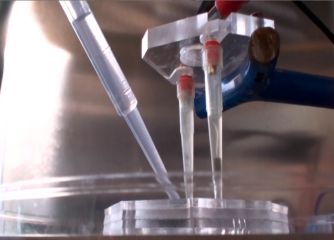Home > Press > Synthetic hydrogels improve testing of active substances in 3-D cell culture
 |
Abstract:
The life science company Cellendes in Germany has developed synthetic hydrogels that make it possible to culture cells in three-dimensional environments. Their invention has fundamental advantages over other hydrogels for three-dimensional cultivation, also on the market.
Synthetic hydrogels improve testing of active substances in 3-D cell culture
Italy | Posted on May 3rd, 2011Many researchers culture cells in flat dishes, two-dimensional culture systems. A disadvantage is that the cells behave differently than they would in a living organism. To offer an environment that resembles the living organism better, Dr. Birgitte Angres and Dr. Helmut Wurst have developed synthetic transparent hydrogels for three-dimensional applications within their life science company Cellendes (Cell-Environment-Design).
"Compared to other hydrogels on the market ours can be much easier modified with bioactive factors such as peptides right at the bench. So customers can choose which peptides they want to include in their culture. They can either purchase them from us or have their own being synthesized. Secondly, the concentration of bioactive factors, such as peptides, in our gels can be much higher than in the competitors' gels," Dr. Helmut Wurst said.
The hydrogels are made in a few minutes by combining two solutions in the form of an activated polymer and a cross-linking agent. Through a chemical reaction the polymers use the agent to link themselves together and a three-dimensional network, where the average pore is about eight nanometers wide, forms. Before the linking occurs it is possible to bind biofactors to the polymer and mix in cells.
The biggest challenge, from a technical point of view, during the development of the hydrogels has been to make these components reproducible. "You can do it once and then the next time maybe a little bit different, but you want to make a reproducible quality of your different components and I think that is the biggest problem," Wurst said.
At the moment Wurst and his colleagues are trying to make it possible to store and ship the gels at room temperature and not in refrigerated conditions, to save costs in shipping. They also want to make the gels form a little bit slower. "The gels form so fast that it is sometimes difficult to mix the two different solutions completely," Wurst said.
Almost all of Cellendes' customers are doing basic research within the field of the life sciences. However, their hydrogels could also be useful in the chemical industry and within drug and cosmetic development. "Efforts are made to reduce the number of experimental animal testings. In our system the cells are cultured in a more natural environment and could replace certain animal models," Wurst said.
Within the European Commission-funded project ProNano -Promoting Technology Transfer of Nanosciences, Nanotechnologies, Materials and new Production Technologies, Cellendes researchers have been selected to receive coaching to make their results in nanotechnologies reach the market.
####
For more information, please click here
Contacts:
Elisabeth Schmid
Phone: +39 027002572
Fax: +39 027002540
E-mail:
Copyright © youris.com
If you have a comment, please Contact us.Issuers of news releases, not 7th Wave, Inc. or Nanotechnology Now, are solely responsible for the accuracy of the content.
| Related News Press |
News and information
![]() Simulating magnetization in a Heisenberg quantum spin chain April 5th, 2024
Simulating magnetization in a Heisenberg quantum spin chain April 5th, 2024
![]() NRL charters Navy’s quantum inertial navigation path to reduce drift April 5th, 2024
NRL charters Navy’s quantum inertial navigation path to reduce drift April 5th, 2024
![]() Discovery points path to flash-like memory for storing qubits: Rice find could hasten development of nonvolatile quantum memory April 5th, 2024
Discovery points path to flash-like memory for storing qubits: Rice find could hasten development of nonvolatile quantum memory April 5th, 2024
Nanomedicine
![]() New micromaterial releases nanoparticles that selectively destroy cancer cells April 5th, 2024
New micromaterial releases nanoparticles that selectively destroy cancer cells April 5th, 2024
![]() Good as gold - improving infectious disease testing with gold nanoparticles April 5th, 2024
Good as gold - improving infectious disease testing with gold nanoparticles April 5th, 2024
![]() Researchers develop artificial building blocks of life March 8th, 2024
Researchers develop artificial building blocks of life March 8th, 2024
Discoveries
![]() Chemical reactions can scramble quantum information as well as black holes April 5th, 2024
Chemical reactions can scramble quantum information as well as black holes April 5th, 2024
![]() New micromaterial releases nanoparticles that selectively destroy cancer cells April 5th, 2024
New micromaterial releases nanoparticles that selectively destroy cancer cells April 5th, 2024
![]() Utilizing palladium for addressing contact issues of buried oxide thin film transistors April 5th, 2024
Utilizing palladium for addressing contact issues of buried oxide thin film transistors April 5th, 2024
Materials/Metamaterials/Magnetoresistance
![]() Nanoscale CL thermometry with lanthanide-doped heavy-metal oxide in TEM March 8th, 2024
Nanoscale CL thermometry with lanthanide-doped heavy-metal oxide in TEM March 8th, 2024
![]() Focused ion beam technology: A single tool for a wide range of applications January 12th, 2024
Focused ion beam technology: A single tool for a wide range of applications January 12th, 2024
Announcements
![]() NRL charters Navy’s quantum inertial navigation path to reduce drift April 5th, 2024
NRL charters Navy’s quantum inertial navigation path to reduce drift April 5th, 2024
![]() Discovery points path to flash-like memory for storing qubits: Rice find could hasten development of nonvolatile quantum memory April 5th, 2024
Discovery points path to flash-like memory for storing qubits: Rice find could hasten development of nonvolatile quantum memory April 5th, 2024
|
|
||
|
|
||
| The latest news from around the world, FREE | ||
|
|
||
|
|
||
| Premium Products | ||
|
|
||
|
Only the news you want to read!
Learn More |
||
|
|
||
|
Full-service, expert consulting
Learn More |
||
|
|
||








